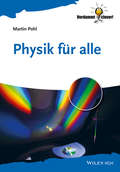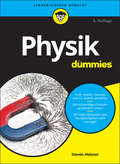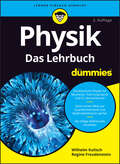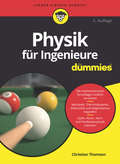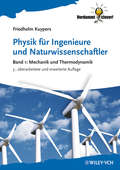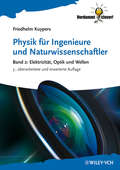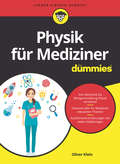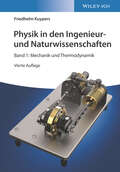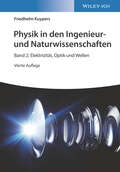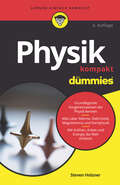- Table View
- List View
Physik des Golfspiels
by Iv N EgryPhysik, die schlau macht. Erfahrener Autor beschreibt die physikalischen Grundlagen beim Golfsport. Für die an Naturwissenschaften interessierten Golfer, die schon immer wissen wollten, wie sie perfekter golfen können.
Physik des Sports
by Leopold Mathelitsch Sigrid ThallerVon Kräfteparallelogramm und Impulserhaltungssatz zu sportlichen Höchstleistungen und Rekorden Sport ist angewandte Physik wer hätte das vermutet? Bei näherem Hinsehen ist dieser Gedanke jedoch gar nicht so abwegig.<P><P> Gerade sind wir zweifach fasziniert, wenn wir Profisportlern bei der »Arbeit« zusehen: Mit ihren trainierten Körpern führen sie scheinbar perfekte Bewegungsabläufe aus. Neuartige Materialien, eine verbesserte Ausrüstung und ein durch Medizin und Sportwissenschaft geleitetes Training verhelfen Sportlerinnen und Sportlern zu immer besseren Leistungen. In der Tat finden keine Weltmeisterschaften und Olympischen Spiele ohne neue Rekorde statt. Doch wie lange noch ist das möglich? Ausgehend von soliden physikalischen Betrachtungen werden die Grenzen des menschlichen Könnens ausgelotet. Mit Physik zum Erfolg:Eine grundlegende Analyse vieler mechanischer Phänomene im Sport Die Autoren nähern sich der Physik des Sports von einem interdisziplinären Standpunkt: Beginnend mit dem Einmaleins der Mechanik, berechnen sie optimale Werte für Sprung und Wurf, um diese Gesetze dann auf den menschlichen Körper und praktische, sportartgebundene Gegebenheiten anzuwenden. Von Ballsport über Geräteturnen bis hin zu Aktivitäten im Wasser belegen Mathelitsch und Thaller damit eindrucksvoll die Universalität der Naturgesetze auch auf diesem Gebiet. Die Erwähnung moderner Methoden, wie die Videoanalyse von Spielzügen und mathematische Modellierung zur Simulation von Bewegungen, rundet das Buch ab. Nach dieser Lektüre werden Sie das Sportprogramm mit anderen Augen sehen.
Physik für Alle (Verdammt clever!)
by Martin PohlPhysik für alle – das schließt neben Naturwissenschaftlern und Lehramtskandidaten auch Geisteswissenschaftler ein. Dieses Buch richtet sich an Leser, die ganz ohne Mathematik die Konzepte der Physik sowie Struktur und grundlegende Aussagen physikalischer Formeln verstehen wollen. Beschrieben wird in leicht verständlicher Form die Physik in der Folge ihrer historischen Entwicklung. Der Schwerpunkt liegt auf der Verwendung von Konzepten und, unter Verwendung einfacher Mathematik, ihrer Formulierung in physikalischen Formeln. Ein weiteres Thema sind die Methoden der Wahrheitsfindung in der Physik. Konzeptionelle Fragen an den Leser sowie Übungsaufgaben am Ende der einzelnen Kapitel bieten Gelegenheit für eine Reflexion und die Festigung der Methoden und Inhalte. Aufgrund des intuitiven Zugangs zu physikalischen Themen und der Diskussion der grundlegenden Konzepte der Physik eignet sich dieses Buch besonders als Einführung in die Physik für alle Nicht-Naturwissenschaftler. Es ist aus der gleichnamigen, sehr erfolgreichen Vorlesung entstanden, die der Autor seit dem Jahr 2010 an der Universität Potsdam hält. Die einzelnen Kapitel sind mit Ausnahme des ersten als in sich abgeschlossene Themenblöcke konzipiert.
Physik für Chemiker I: Physikalische Grundlagen, Mechanik, Thermodynamik
by Olaf FritscheDas Arbeitsbuch führt durch das erfolgreiche Lehrbuch der Physik von Tipler et al. und ist explizit für das Selbststudium konzipiert.
Physik für Chemiker II: Elektrizität, Magnetismus, Optik, Quanten- und Atomphysik
by Olaf FritscheDas Arbeitsbuch führt durch das erfolgreiche Lehrbuch der Physik von Tipler et al. und ist explizit für das Selbststudium konzipiert.
Physik für Dummies (Für Dummies)
by Steven HolznerVon Ampere bis Zentripetalkraft – alles, was Sie über Physik wissen müssen Lässt Thermodynamik Sie kalt? Stößt Magnetismus Sie ab? Oder springt der Funke der Elektrizität einfach nicht auf Sie über? Kein Problem, Physik für Dummies entführt auch die, die damit eigentlich nichts am Hut haben, in die faszinierende Welt der Physik. Steve Holzner stellt Ihnen physikalische Phänomene vor und erklärt die dahinterstehenden Naturgesetze samt der notwendigen mathematischen Grundlagen. Egal ob Energie, Wärme oder Licht, alles wird mit ausführlichen Beispielen und anschauli‑ chen Abbildungen erläutert. Nach jedem Kapitel finden Sie Übungsaufgaben und Lösungen, mit denen Sie das Gelernte festigen können.
Physik für Dummies (Für Dummies)
by Steven Holzner"Physik für Dummies" entführt auch die, die damit eigentlich nichts am Hut haben, in die faszinierende Welt der Physik. Steve Holzner stellt Ihnen physikalische Phänomene vor und erklärt die dahinterstehenden Naturgesetze samt der notwendigen mathematischen Grundlagen. Egal ob Elektrizität, Magnetismus oder Optik, alles wird mit ausführlichen Beispielen und anschaulichen Abbildungen erläutert. Nach jedem Kapitel gibt es Übungsaufgaben und Lösungen, mit denen man das Gelernte festigen kann.
Physik für Dummies: Das Lehrbuch (Für Dummies)
by Wilhelm Kulisch Regine FreudensteinDie Physik auf etwas mehr als einen Blick Physik kann ganz schön kompliziert sein, besonders wenn es etwas mehr in die Tiefe geht. Dass man aber auch komplizierte Dinge leicht verständlich und bisweilen amüsant erklären kann, beweist dieses Buch. Wilhelm Kulisch und Regine Freudenstein erläutern, was Sie über Mechanik, Kontinuumsmechanik, Schwingungen, Wellen, Elektromagnetismus, Thermodynamik und Optik wissen sollten. Aber auch die makroskopische und mikroskopische moderne Physik kommen mit Relativitätstheorie und Quantenphysik nicht zu kurz. Zahlreiche Übungsaufgaben mit Lösungen runden das Buch ab. Sie erfahren Was Kapazität, magnetische Induktion und Halbleiter sind Was es mit der Wellennatur des Lichts, der Polarisation und dem elektromagnetischen Spektrum auf sich hat Was es zu Pulsaren, schwarzen Löchern und der Urknalltheorie zu wissen gibt
Physik für Ingenieure
by Ekbert Hering Rolf Martin Martin StohrerDieses Lehrbuch zeichnet sich durch klare Strukturen, bewährte Didaktik und Übersichten zur Veranschaulichung komplexer Zusammenhänge aus. Zahlreiche Abbildungen aus der Technik und Berechnungsbeispiele aus dem Arbeitsumfeld des Ingenieurs vermitteln den Praxisbezug. Übungsaufgaben und deren ausführliche Lösungen ermöglichen es, physikalische Zusammenhänge rechnerisch zu erfassen und vertiefen ihr Verständnis. Dieses erfolgreiche Standardwerk erscheint in seiner 12. Auflage. Auf den Innenseiten des Einbands finden sich nun in übersichtlicher Zusammenstellung wichtige physikalische Naturkonstanten, eine Tabelle zur Umrechnung von Energieäquivalenten sowie eine Liste öfters anzutreffender, jedoch nicht mit dem SI konformer Maßeinheiten. Die Zielgruppen Das Lehrbuch wendet sich an Studierende der Natur- und Ingenieurwissenschaften sowie an Ingenieure in der Praxis, die eine kompakte Darstellung des physikalischen Wissens schätzen.
Physik für Ingenieure
by Ekbert Hering Rolf Martin Martin StohrerDieses Lehrbuch zeichnet sich durch klare Strukturen, bewährte Didaktik und Übersichten zur Veranschaulichung komplexer Zusammenhänge aus. Zahlreiche Abbildungen aus der Technik und Berechnungsbeispiele aus dem Arbeitsumfeld eines Ingenieurs vermitteln den Praxisbezug. Übungsaufgaben und deren ausführliche Lösungen ermöglichen es, physikalische Zusammenhänge rechnerisch zu erfassen und vertiefen ihr Verständnis. Dieses erfolgreiche Standardwerk erscheint in seiner 14. Auflage.
Physik für Ingenieure für Dummies (Für Dummies)
by Christian ThomsenAlles ist Physik und natürlich müssen sich angehende Ingenieure damit beschäftigen. Die Physik fällt Ihnen schwer? Ihnen fehlen die mathematischen Grundlagen? Keine Panik! Dieses Buch wird Ihnen helfen. Es enthält alles, was Sie über Mechanik, Thermodynamik, Elektrizität, Magnetismus, Optik, Atom-, Kern- und Festkörperphysik wissen sollten, um im Studium zu bestehen - und die mathematischen Grundlagen dazu. Schritt für Schritt hilft Ihnen dieses Buch über die mathematischen und physikalischen Hürden. Da Ihnen zahlreiche Beispiele vorgerechnet werden, werden Sie sich in der Welt der Physik bald immer sicherer fühlen.
Physik für Ingenieure und Naturwissenschaftler: Band 1 - Mechanik und Thermodynamik (Verdammt clever!)
by Friedhelm KuypersMit diesem zweibändigen Werk liegt wiederum eine erneuerte und verbesserte Auflage des bewährten Lehrbuchs von Friedhelm Kuypers vor. Band 1 widmet sich der Mechanik und Thermodynamik. Die Mechanik wurde durch ausführliche Beträge zu erneuerbaren Energien und zu Windkraftanlagen ergänzt. Zahlreiche Beispiele beleuchten die Zusammenhänge zwischen technischen Anwendungen, alltäglichen Phänomenen und physikalischen Gesetzen. Der Aufbau und die Aufbereitung des Stoffes sind auf eine effektive Prüfungsvorbereitung zugeschnitten. Jedes Kapitel endet mit einer Zusammenfassung des Basiswissens und der wichtigsten Lernschritte. Zahlreiche Aufgaben in verschiedenen Schwierigkeitsgraden mit ausführlichen Lösungen bieten ideale Trainingsmöglichkeiten.
Physik für Ingenieure und Naturwissenschaftler: Band 2: Elektrizität, Optik und Wellen (Verdammt clever!)
by Friedhelm KuypersMit diesem zweibändigen Werk liegt wiederum eine erneuerte und verbesserte Auflage des bewährten Lehrbuchs von Friedhelm Kuypers vor. Band 2 umfasst die Elektrodynamik, Optik und Wellenlehre. Unter anderem werden folgende Themen behandelt: LCD-Fernseher, Laserdrucker, CD- und DVD-Spieler, Lichtleiter, Abschirmung von Feldern, Drehstrom. Zusammenhänge zwischen technischen Anwendungen, alltäglichen Phänomenen und physikalischen Gesetzen werden beleuchtet. Der Aufbau und die Aufbereitung des Stoffes sind auf eine effektive Prüfungsvorbereitung zugeschnitten. Jedes Kapitel endet mit einer Zusammenfassung des Basiswissens und der wichtigsten Lernschritte. Zahlreiche Aufgaben in verschiedenen Schwierigkeitsgraden mit ausführlichen Lösungen bieten ideale Trainingsmöglichkeiten.
Physik für Mediziner für Dummies (Für Dummies)
by Oliver KleinDas Studium der Medizin ist anstrengend und zeitintensiv und dann muss man sich auch noch mit Physik herumschlagen. Oliver Klein erklärt Ihnen in diesem Buch praxisnah die nötigen Grundlagen, und macht nebenbei klar, warum ein grundlegendes Verständnis für die Physik für Mediziner so wichtig ist. Von Mechanik über Elektrizitätslehre und Optik bis zu Schwingungen und Atomphysik ist alles dabei, was Sie als angehender Mediziner laut Gegenstandskatalog des IMPP über Physik wissen müssen. Durch zahlreiche Abbildungen und viele Beispiele aus der Praxis sind komplexe Themen plötzlich ganz leicht verständlich. So kann das Physikum kommen!
Physik für Studierende der Biowissenschaften, Chemie und Medizin
by Gerhard RufaDieses Lehrbuch bietet eine klar strukturierte Einführung in die Physik, wobei die Grundlagen, wie sie für Studierende mit Physik im Nebenfach benötigt werden, in einer leicht verständlichen Weise dargestellt werden. Die physikalischen Begriffe und Gesetzmäßigkeiten werden anhand vieler Abbildungen sowie durch Beispiele aus dem täglichen Leben, den Biowissenschaften, der Chemie und der Medizin erläutert. Vorkenntnisse aus der Physik werden nicht vorausgesetzt, sodass Studierende sich selbstständig das physikalische Grundlagenwissen erarbeiten können und ein Verständnis der abstrakten physikalischen Begriffe und Gesetzmäßigkeiten erhalten.Ergänzt wird dieses Lehrbuch von dem separaten Übungsbuch Physik für Studierende der Biowissenschaften, Chemie und Medizin, das eine Vielzahl von Übungsserien und Testserien mit ausführlichen Lösungen und Erklärungen enthält. Es hilft Studierenden, sich anhand ausgewählter physikalischer Probleme Schritt für Schritt die Physik und auch die erforderliche Mathematik zu erarbeiten. Beide Bücher eignen sich somit hervorragend als Ergänzung zur Vorlesung sowie für die Klausurvorbereitung.
Physik für das Ingenieurstudium: Prägnant mit vielen Lernkontrollfragen und Beispielaufgaben
by Jürgen Eichler Andreas ModlerDieses praxisnahe Lehrbuch vermittelt die physikalischen Grundlagen in den Ingenieurwissenschaften auf kompakte und prägnante Weise. Die zugrundeliegenden mathematischen Zusammenhänge werden verständlich formuliert, während viele Tabellen und Abbildungen für eine hohe Übersichtlichkeit sorgen. Unterstützt wird das Verständnis durch moderne Beispiele aus Technik und Umwelt. Die vorliegende 7. Auflage wurde unter anderem in Bezug auf die überarbeitete SI-Einheitensystematik erweitert.
Physik ganz smart: Die Gesetze der Welt mit dem Smartphone entdecken
by Jochen Kuhn Patrik VogtIm vorliegenden Buch werden rund 50 physikalische Experimente vorgestellt, in denen Smartphones oder Tablet-Computer zur Messwerterfassung genutzt werden. Die Autoren decken zahlreiche Themenfelder der Physik ab: Kinematik und Dynamik, Hydrostatik und -Dynamik, Mechanische Schwingungen und Wellen, Akustik, Elektrodynamik und Radioaktivität. Leserinnen und Leser untersuchen beispielsweise mit den Beschleunigungssensoren des Smartphones den freien Fall, messen die Flügelschlagfrequenz von Insekten, bestimmen die Klopfspecht-Art mithilfe ihrer Akustik und untersuchen, wie stark unterschiedliche Materialien radioaktive Strahlung abschirmen. Für jedes Experiment wird der theoretische Hintergrund, die Versuchsdurchführung und -Auswertung besprochen. Eine Aufstellung der genutzten Apps, einschließlich Bezugsquellen und Hinweise zu anfallenden Kosten, ist am Ende des Buches aufgelistet.Alle vorgestellten Experimente sind bewusst als Einzelbeiträge verfasst und können somit unabhängig voneinander gelesen und erprobt werden. Dadurch ist man nicht an die vorgegebene Reihenfolge gebunden und kann sich beim Durcharbeiten des Buches allein von den persönlichen Interessen leiten lassen.Das Buch richtet sich an alle Dozierenden des Fachs Physik, Studierende des Lehramts, Referendarinnen und Referendare, ausgebildete Lehrerinnen und Lehrer und hilft bei der Unterrichtsgestaltung, Ideenfindung und letztendlich Einbindung moderner Medien im Physikunterricht.Die HerausgeberProf. Dr. Jochen Kuhn hat 2002 an der Universität Koblenz-Landau promoviert und dort 2009 habilitiert. Er ist seit 2012 Universitätsprofessor an der Technischen Universität Kaiserslautern und Leiter der Arbeitsgruppe „Didaktik der Physik“. Sein Arbeits- und Forschungsschwerpunkt ist das fachbezogene Lehren und Lernen mit digitalen Medien in Schule und Hochschule.Dr. Patrik Vogt hat sich nach einem Lehramtsstudium in Landau und dem Referendariat in Kaiserslautern im Jahr 2010 am Fachbereich „Natur- und Umweltwissenschaften“ der Universität Koblenz-Landau mit einer Arbeit zur Physikdidaktik promoviert. Nach mehreren Stationen als wissenschaftlicher Mitarbeiter und Realschullehrer leitet er seit 2019 den Fachbereich „Medienbildung, Mathematik, Naturwissenschaften“ am Institut für Lehrerfort- und -weiterbildung in Mainz. Seine Arbeitsschwerpunkte bilden die Einsatzmöglichkeiten mobiler Endgeräte im Physikunterricht, speziell als Messinstrument, die Aufgabenkultur sowie die Physik des Alltags.
Physik im Alltag für Dummies (Für Dummies)
by Wilhelm KulischWenn man so will, lässt sich so ziemlich alles, was wir um uns herum sehen, auf physikalische Phänomene zurückführen. Wilhelm Kulisch erklärt Ihnen von der Warte eines Physikers die Dinge, die Ihnen in Ihrem Alltag begegnen. Seien es nun Auto und Fahrrad, Mikrowelle und Kühlschrank, Blitz und Regenbogen und vieles mehr. Kurz und knapp beschreibt er, was es hierzu zu wissen gibt, und ermöglicht Ihnen so eine andere Sicht auf die Dinge, die Sie vielleicht sonst als alltäglich kaum wahrgenommen haben oder bei denen Sie sich schon immer gefragt haben, was denn da wohl dahinter steckt.
Physik in den Ingenieur- und Naturwissenschaften, Band 1: Mechanik und Thermodynamik
by Friedhelm KuypersAnschaulichkeit vor Formalismus - die unvergleichlich verständliche Einführung in die Mechanik und Thermodynamik für Studierende der Natur- und Ingenieurwissenschaften in neuer Auflage! Elektrotechnik, Maschinenbau, Chemie, Geophysik, Biologie: eine Einführung in die Physik gehört für alle Studierende der Natur- und Ingenieurwissenschaften unumgänglich zum Studium dazu, sei es im Rahmen der Physikvorlesungen für Hauptfachstudierende oder in Form auf spezifische Studiengänge zugeschnittener Veranstaltungen. Die vierte Auflage des Lehrbuchklassikers von Friedhelm Kuypers gibt in gewohnt anschaulicher Weise eine Einführung in die Mechanik und die Thermodynamik; neu hinzugekommen sind ein leicht verständlicher à berblick zum schwer greifbaren Thema Entropie und zu erneuerbaren Energien. Jeder Abschnitt wurde vollständig überarbeitet, um noch besser auf immer wieder vorkommende Probleme der Studierenden einzugehen. Im Aufgaben- und Lösungsteil werden die mittleren und schweren Aufgaben mit einer anschaulichen Vorstellung der behandelten Physik eingeleitet, bevor die eigentlichen Rechnungen beginnen.
Physik in den Ingenieur- und Naturwissenschaften, Band 2: Elektrizität, Optik und Wellen
by Friedhelm KuypersAnschaulichkeit vor Formalismus - die unvergleichlich verständliche Einführung in die Elektrostatik und -dynamik und Optik für Studierende der Natur- und Ingenieurwissenschaften in neuer Auflage! Elektrotechnik, Maschinenbau, Chemie, Geophysik, Biologie: eine Einführung in die Physik gehört für alle Studierende der Natur- und Ingenieurwissenschaften unumgänglich zum Studium dazu, sei es im Rahmen der Physikvorlesungen für Hauptfachstudierende oder in Form auf spezifische Studiengänge zugeschnittener Veranstaltungen. Die vierte Auflage des Lehrbuchklassikers von Friedhelm Kuypers gibt in gewohnt anschaulicher Weise eine Einführung in die Elektrostatik und -dynamik und die Optik, wobei die physikalischen Grundlagen stets mit der Darstellung von Anwendungen aus dem Alltag flankiert werden. Jeder Abschnitt wurde vollständig überarbeitet, um noch besser auf immer wieder vorkommende Probleme der Studierenden einzugehen. Im Aufgaben- und Lösungsteil werden die mittleren und schweren Aufgaben nun mit einer anschaulichen Vorstellung der behandelten Physik eingeleitet, bevor die eigentlichen Rechnungen beginnen.
Physik kompakt für Dummies (Für Dummies)
by Steven HolznerSie suchen einen leicht verständlichen Einstieg in die Physik oder möchten Ihre Grundkenntnisse auffrischen? Dieses Buch hilft Ihnen dabei, sich einen schnellen à berblick über die Physik zu verschaffen. Steven Holzner erklärt Ihnen, was Sie über Kräfte und Bewegungen, Energie, Wärme, Licht, elektrische Felder und Kernphysik unbedingt wissen sollten. So ist dies Ihr perfekter Nachhilfelehrer für die Tasche: freundlich, kompetent, günstig.
Physik mit Barrique: Eine Weinprobe in 50 Experimenten
by Patrik Vogt Lutz KasperEine noch geschlossene Weinflasche, ein Korkenzieher und ein Smartphone sind fraglos eine vielversprechende Kombination. Mit dem einen Gerät gute Freunde benachrichtigen und mit dem anderen den Korken aus der Flasche ziehen – was will man mehr? Vielleicht dürstet aber neben der Kehle auch der „Geist“! Mit diesem Buch üben Sie Ihre physikalische Achtsamkeit beim Weingenuss: Sie erfahren, wie man mit dem charakteristischen Plopp-Geräusch beim Öffnen der Flasche die Schallgeschwindigkeit bestimmen kann, wie man einen Wein am besten karaffiert, welche Besonderheiten Rotwein im Laserlicht zeigt und was Pythagoras mit Wein zu tun hat. Physik mit Barrique schafft die wunderbare Verbindung von Wissenschaft und Wein. Ein inspirierendes Sachbuch – mit Experimenten zum Mitmachen und Nachmachen oder einfach nur Genießen. Die Autoren Lutz Kasper hat Mathematik und Physik auf Lehramt in Hannover studiert und in Physikdidaktik an der Universität Potsdam promoviert. Seit 2011 ist er Professor für Physik und ihre Didaktik an der PH Schwäbisch Gmünd. Patrik Vogt hat sich nach einem Lehramtsstudium in Landau und dem Referendariat in Kaiserslautern im Jahr 2010 am Fachbereich „Natur- und Umweltwissenschaften“ der Universität Koblenz-Landau mit einer Arbeit zur Physikdidaktik promoviert. Nach mehreren Stationen als wissenschaftlicher Mitarbeiter und Realschullehrer leitet er seit 2019 den Fachbereich „Medienbildung, Mathematik, Naturwissenschaften, Musik, Philosophie“ am Institut für Lehrerfort- und -weiterbildung in Mainz. Seine Arbeitsschwerpunkte bilden die Einsatzmöglichkeiten mobiler Endgeräte im Physikunterricht, speziell als Messinstrument, die Aufgabenkultur sowie die Physik des Alltags.
Physik ohne Realität: Tiefsinn oder Wahnsinn?
by H. Dieter ZehBeschreiben die Begriffe der modernen Physik tatsächlich die Realität oder sind sie nur Hilfsmittel und Rechenwerkzeuge? Wie können reale Objekte aus Atomen aufgebaut sein, wenn diese angeblich gar keine realen Eigenschaften vor deren Messung besitzen? In philosophischen und meist allgemein verständlichen Aufsätzen setzt sich der Autor - Begründer des Dekohärenzkonzepts in der Quantentheorie - mit den "faulen Ausreden" auseinander, die Physiker finden, um unerwarteten Konsequenzen, die sich aus ihren eigenen Theorien ergeben, aus dem Weg zu gehen.
Physik studiert - und dann?: 24 Interviews aus der Arbeitswelt
by Nina Niebuhr Jeannette Jansen Katharina SpindeldreierDu studierst Physik oder willst Physik studieren? Du findest Physik spannend, kannst dir aber noch nicht so ganz vorstellen, welche Berufswege man damit später einschlagen kann? Dieses Buch gibt dir einen Einblick in die Welt jenseits des Studiums: 24 Physikerinnen und Physiker aus den unterschiedlichsten Berufsrichtungen geben in Interviews einen Einblick in ihr Tätigkeitsfeld und ihren Weg dorthin. Persönliche und berufsorientierte Tipps helfen bei der beruflichen Orientierung.Aus dem Inhalt:Physikerinnen und Physiker im BerufIndustrie – Forschung auf den Markt bringenSoftware – Mit dem Algorithmus zur LösungWissensvermittlung – Physik greifbar machenWissenschaft in Anwendung – Arbeitsweisen übertragenPhysik und Gesellschaft – die Physik bietet noch mehr
Physik unserer Umwelt: Die Atmosphäre
by Thomas Wagner Walter RoedelDas Buch basiert auf einer zweisemestrigen Vorlesung an der Universität Heidelberg über die Physik der Atmosphäre. Der Autor erklärt einerseits das System Atmosphäre und vermittelt andererseits umweltrelevante Aspekte. Die Neuauflage wurde zum Teil grundlegend überarbeitet. So wurden für die Kapitel zu Spurenstoffen und zur Klimamodellierung die neuesten Forschungserkenntnisse eingearbeitet, das Kapitel über Aerosole um Abschnitte zu deren chemischer Bedeutung ergänzt. Mit umfangreichem Register sowie ausführlichen Quellen- und Literaturangaben.


